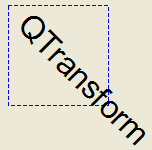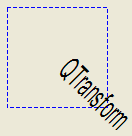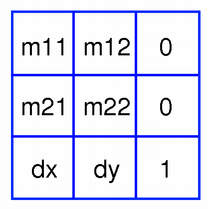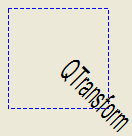| Home · All Classes · Main Classes · Grouped Classes · Modules · Functions |
The QTransform class specifies 2D transformations of a coordinate system. More...
#include <QTransform>
This class was introduced in Qt 4.3.
The QTransform class specifies 2D transformations of a coordinate system.
A transformation specifies how to translate, scale, shear, rotate or project the coordinate system, and is typically used when rendering graphics.
QTransform differs from QMatrix in that it is a true 3x3 matrix, allowing perpective transformations. QTransform's toAffine() method allows casting QTransform to QMatrix. If a perspective transformation has been specified on the matrix, then the conversion to an affine QMatrix will cause loss of data.
QTransform is the recommended transformation class in Qt.
A QTransform object can be built using the setMatrix(), scale(), rotate(), translate() and shear() functions. Alternatively, it can be built by applying basic matrix operations. The matrix can also be defined when constructed, and it can be reset to the identity matrix (the default) using the reset() function.
The QTransform class supports mapping of graphic primitives: A given point, line, polygon, region, or painter path can be mapped to the coordinate system defined by this matrix using the map() function. In case of a rectangle, its coordinates can be transformed using the mapRect() function. A rectangle can also be transformed into a polygon (mapped to the coordinate system defined by this matrix), using the mapToPolygon() function.
QTransform provides the isIdentity() function which returns true if the matrix is the identity matrix, and the isInvertible() function which returns true if the matrix is non-singular (i.e. AB = BA = I). The inverted() function returns an inverted copy of this matrix if it is invertible (otherwise it returns the identity matrix). In addition, QTransform provides the det() function returning the matrix's determinant.
Finally, the QTransform class supports matrix multiplication, and objects of the class can be streamed as well as compared.
When rendering graphics, the matrix defines the transformations but the actual transformation is performed by the drawing routines in QPainter.
By default, QPainter operates on the associated device's own coordinate system. The standard coordinate system of a QPaintDevice has its origin located at the top-left position. The x values increase to the right; y values increase downward. For a complete description, see the coordinate system documentation.
QPainter has functions to translate, scale, shear and rotate the coordinate system without using a QTransform. For example:
 | void SimpleTransformation::paintEvent(QPaintEvent *)
{
QPainter painter(this);
painter.setPen(QPen(Qt::blue, 1, Qt::DashLine));
painter.drawRect(0, 0, 100, 100);
painter.rotate(45);
painter.setFont(QFont("Helvetica", 24));
painter.setPen(QPen(Qt::black, 1));
painter.drawText(20, 10, "QTransform");
}
|
Although these functions are very convenient, it can be more efficient to build a QTransform and call QPainter::setTransform() if you want to perform more than a single transform operation. For example:
 | void CombinedTransformation::paintEvent(QPaintEvent *)
{
QPainter painter(this);
painter.setPen(QPen(Qt::blue, 1, Qt::DashLine));
painter.drawRect(0, 0, 100, 100);
QTransform transform;
transform.translate(50, 50);
transform.rotate(45);
transform.scale(0.5, 1.0);
painter.setTransform(transform);
painter.setFont(QFont("Helvetica", 24));
painter.setPen(QPen(Qt::black, 1));
painter.drawText(20, 10, "QTransform");
}
|

A QTransform object contains a 3 x 3 matrix. The dx and dy elements specify horizontal and vertical translation. The m11 and m22 elements specify horizontal and vertical scaling. And finally, the m21 and m12 elements specify horizontal and vertical shearing.
QTransform transforms a point in the plane to another point using the following formulas:
x' = m11*x + m21*y + dx y' = m22*y + m12*x + dy
The point (x, y) is the original point, and (x', y') is the transformed point. (x', y') can be transformed back to (x, y) by performing the same operation on the inverted() matrix.
The various matrix elements can be set when constructing the matrix, or by using the setMatrix() function later on. They also be manipulated using the translate(), rotate(), scale() and shear() convenience functions, The currently set values can be retrieved using the m11(), m12(), m21(), m22(), dx() and dy() functions.
Translation is the simplest transformation. Setting dx and dy will move the coordinate system dx units along the X axis and dy units along the Y axis. Scaling can be done by setting m11 and m22. For example, setting m11 to 2 and m22 to 1.5 will double the height and increase the width by 50%. The identity matrix has m11 and m22 set to 1 (all others are set to 0) mapping a point to itself. Shearing is controlled by m12 and m21. Setting these elements to values different from zero will twist the coordinate system. Rotation is achieved by carefully setting both the shearing factors and the scaling factors.
Here's the combined transformations example using basic matrix operations:
 | void BasicOperations::paintEvent(QPaintEvent *)
{
double pi = 3.14;
double a = pi/180 * 45.0;
double sina = sin(a);
double cosa = cos(a);
QTransform translationTransform(1, 0, 0, 1, 50.0, 50.0);
QTransform rotationTransform(cosa, sina, -sina, cosa, 0, 0);
QTransform scalingTransform(0.5, 0, 0, 1.0, 0, 0);
QTransform transform;
transform = scalingTransform * rotationTransform * translationTransform;
QPainter painter(this);
painter.setPen(QPen(Qt::blue, 1, Qt::DashLine));
painter.drawRect(0, 0, 100, 100);
painter.setTransform(transform);
painter.setFont(QFont("Helvetica", 24));
painter.setPen(QPen(Qt::black, 1));
painter.drawText(20, 10, "QTransform");
}
|
See also QPainter, The Coordinate System, Affine Transformations Demo, and Transformations Example.
| Constant | Value |
|---|---|
| QTransform::TxNone | 0x00 |
| QTransform::TxTranslate | 0x01 |
| QTransform::TxScale | 0x02 |
| QTransform::TxRotate | 0x04 |
| QTransform::TxShear | 0x08 |
| QTransform::TxProject | 0x10 |
Constructs an identity matrix.
All elements are set to zero except m11 and m22 (specifying the scale) and m13 which are set to 1.
See also reset().
Constructs a matrix with the elements, h11, h12, h13, h21, h22, h23, h31, h32, h33.
See also setMatrix().
Constructs a matrix with the elements, h11, h12, h21, h22, dx and dy.
See also setMatrix().
Constructs a matrix that is a copy of the given matrix. Note that the m13, m23, and m33 elements are set to 0, 0, and 1 respectively.
Returns the horizontal scaling factor.
See also scale() and Basic Matrix Operations.
Returns the vertical shearing factor.
See also shear() and Basic Matrix Operations.
Returns the horizontal projection factor.
See also translate() and Basic Matrix Operations.
Returns the horizontal shearing factor.
See also shear() and Basic Matrix Operations.
Returns the vertical scaling factor.
See also scale() and Basic Matrix Operations.
Returns the vertical projection factor.
See also translate() and Basic Matrix Operations.
Returns the horizontal translation factor.
See also dx(), translate(), and Basic Matrix Operations.
Returns the vertical translation factor.
See also dy(), translate(), and Basic Matrix Operations.
Returns the division factor.
See also translate() and Basic Matrix Operations.
Returns the adjoint of this matrix.
Returns the matrix's determinant.
Returns the matrix's determinant.
Returns the horizontal translation factor.
See also m31(), translate(), and Basic Matrix Operations.
Returns the vertical translation factor.
See also translate() and Basic Matrix Operations.
Returns an inverted copy of this matrix.
If the matrix is singular (not invertible), the returned matrix is the identity matrix. If invertible is valid (i.e. not 0), its value is set to true if the matrix is invertible, otherwise it is set to false.
See also isInvertible().
Returns true if the matrix represent an affine transformation, otherwise returns false.
Returns true if the matrix is the identity matrix, otherwise returns false.
See also reset().
Returns true if the matrix is invertible, otherwise returns false.
See also inverted().
Returns true if the matrix represents some kind of a rotating transformation, otherwise returns false.
See also reset().
Returns true if the matrix represents a scaling transformation, otherwise returns false.
See also reset().
Returns true if the matrix represents a translating transformation, otherwise returns false.
See also reset().
Maps the given coordinates x and y into the coordinate system defined by this matrix. The resulting values are put in *tx and *ty, respectively.
The coordinates are transformed using the following formulas:
x' = m11*x + m21*y + dx y' = m22*y + m12*x + dy
The point (x, y) is the original point, and (x', y') is the transformed point.
See also Basic Matrix Operations.
This is an overloaded member function, provided for convenience.
Creates and returns a QPointF object that is a copy of the given point, p, mapped into the coordinate system defined by this matrix.
This is an overloaded member function, provided for convenience.
Creates and returns a QPoint object that is a copy of the given point, mapped into the coordinate system defined by this matrix. Note that the transformed coordinates are rounded to the nearest integer.
This is an overloaded member function, provided for convenience.
Creates and returns a QLineF object that is a copy of the given line, l, mapped into the coordinate system defined by this matrix.
This is an overloaded member function, provided for convenience.
Creates and returns a QLine object that is a copy of the given line, mapped into the coordinate system defined by this matrix. Note that the transformed coordinates are rounded to the nearest integer.
This is an overloaded member function, provided for convenience.
Creates and returns a QPolygonF object that is a copy of the given polygon, mapped into the coordinate system defined by this matrix.
This is an overloaded member function, provided for convenience.
Creates and returns a QPolygon object that is a copy of the given polygon, mapped into the coordinate system defined by this matrix. Note that the transformed coordinates are rounded to the nearest integer.
This is an overloaded member function, provided for convenience.
Creates and returns a QRegion object that is a copy of the given region, mapped into the coordinate system defined by this matrix.
Calling this method can be rather expensive if rotations or shearing are used.
This is an overloaded member function, provided for convenience.
Creates and returns a QPainterPath object that is a copy of the given path, mapped into the coordinate system defined by this matrix.
This is an overloaded member function, provided for convenience.
Maps the given coordinates x and y into the coordinate system defined by this matrix. The resulting values are put in *tx and *ty, respectively. Note that the transformed coordinates are rounded to the nearest integer.
Creates and returns a QRectF object that is a copy of the given rectangle, mapped into the coordinate system defined by this matrix.
The rectangle's coordinates are transformed using the following formulas:
x' = m11*x + m21*y + dx
y' = m22*y + m12*x + dy
if (is not affine) {
w' = m13*x + m23*y + m33
x' /= w'
y' /= w'
}
If rotation or shearing has been specified, this function returns the bounding rectangle. To retrieve the exact region the given rectangle maps to, use the mapToPolygon() function instead.
See also mapToPolygon() and Basic Matrix Operations.
This is an overloaded member function, provided for convenience.
Creates and returns a QRect object that is a copy of the given rectangle, mapped into the coordinate system defined by this matrix. Note that the transformed coordinates are rounded to the nearest integer.
Creates and returns a QPolygon representation of the given rectangle, mapped into the coordinate system defined by this matrix.
The rectangle's coordinates are transformed using the following formulas:
x' = m11*x + m21*y + dx
y' = m22*y + m12*x + dy
if (is not affine) {
w' = m13*x + m23*y + m33
x' /= w'
y' /= w'
}
Polygons and rectangles behave slightly differently when transformed (due to integer rounding), so matrix.map(QPolygon(rectangle)) is not always the same as matrix.mapToPolygon(rectangle).
See also mapRect() and Basic Matrix Operations.
Creates a transformation matrix, trans, that maps a four-sided polygon, one, to another four-sided polygon, two. Returns true if the transformation is possible; otherwise returns false.
This is a convenience method combining quadToSquare() and squareToQuad() methods. It allows the input quad to be transformed into any other quad.
See also squareToQuad() and quadToSquare().
Creates a transformation matrix, trans, that maps a four-sided polygon, quad, to a unit square. Returns true if the transformation is constructed or false if such a transformation does not exist.
See also squareToQuad() and quadToQuad().
Resets the matrix to an identity matrix, i.e. all elements are set to zero, except m11 and m22 (specifying the scale) which are set to 1.
See also QTransform(), isIdentity(), and Basic Matrix Operations.
Rotates the coordinate system counterclockwise by the given angle about the specified axis and returns a reference to the matrix.
Note that if you apply a QTransform to a point defined in widget coordinates, the direction of the rotation will be clockwise because the y-axis points downwards.
The angle is specified in degrees.
See also setMatrix().
Rotates the coordinate system counterclockwise by the given angle about the specified axis and returns a reference to the matrix.
Note that if you apply a QTransform to a point defined in widget coordinates, the direction of the rotation will be clockwise because the y-axis points downwards.
The angle is specified in radians.
See also setMatrix().
Scales the coordinate system by sx horizontally and sy vertically, and returns a reference to the matrix.
See also setMatrix().
Sets the matrix elements to the specified values, m11, m12, m13 m21, m22, m23 m31, m32 and m33. Note that this function replaces the previous values. QMatrix provides the translate(), rotate(), scale() and shear() convenience functions to manipulate the various matrix elements based on the currently defined coordinate system.
See also QTransform().
Shears the coordinate system by sh horizontally and sv vertically, and returns a reference to the matrix.
See also setMatrix().
Creates a transformation matrix, trans, that maps a unit square to a four-sided polygon, quad. Returns true if the transformation is constructed or false if such a transformation does not exist.
See also quadToSquare() and quadToQuad().
Returns the QTransform cast to a QMatrix.
Moves the coordinate system dx along the x axis and dy along the y axis, and returns a reference to the matrix.
See also setMatrix().
Returns the transpose of this matrix.
Returns the transformation type of this matrix.
Returns the transform as a QVariant.
Returns true if this matrix is not equal to the given matrix, otherwise returns false.
Returns the result of multiplying this matrix by the given matrix.
Note that matrix multiplication is not commutative, i.e. a*b != b*a.
Returns the result of multiplying this matrix by the given matrix.
This is an overloaded member function, provided for convenience.
Returns the result of performing an element-wise multiplication of this matrix with the given scalar.
Returns the matrix obtained by adding the given scalar to each element of this matrix.
Returns the matrix obtained by subtracting the given scalar from each element of this matrix.
Returns the result of performing an element-wise division of this matrix by the given scalar.
Assigns the given matrix's values to this matrix.
Returns true if this matrix is equal to the given matrix, otherwise returns false.
This is an overloaded member function, provided for convenience.
This is the same as matrix.map(point).
See also QTransform::map().
This is an overloaded member function, provided for convenience.
Same as matrix.map(point).
See also QTransform::map().
This is an overloaded member function, provided for convenience.
This is the same as matrix.map(line).
See also QTransform::map().
This is an overloaded member function, provided for convenience.
This is the same as matrix.map(line).
See also QTransform::map().
This is an overloaded member function, provided for convenience.
This is the same as matrix.map(polygon).
See also QTransform::map().
This is an overloaded member function, provided for convenience.
This is the same as matrix.map(polygon).
This function was introduced in Qt 4.3.
See also QTransform::map().
This is an overloaded member function, provided for convenience.
This is the same as matrix.map(region).
See also QTransform::map().
This is an overloaded member function, provided for convenience.
This is the same as matrix.map(path).
This function was introduced in Qt 4.3.
See also QTransform::map().
This is an overloaded member function, provided for convenience.
Writes the given matrix to the given stream and returns a reference to the stream.
This function was introduced in Qt 4.3.
See also Format of the QDataStream Operators.
This is an overloaded member function, provided for convenience.
Reads the given matrix from the given stream and returns a reference to the stream.
This function was introduced in Qt 4.3.
See also Format of the QDataStream Operators.
| Copyright © 2008 Trolltech | Trademarks | Qt 4.3.5 |